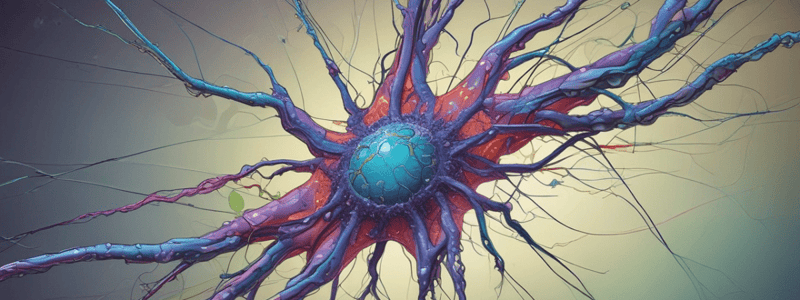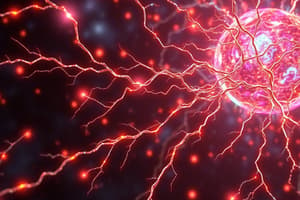Podcast
Questions and Answers
What is the minimum number of amino acids required for a signal sequence to appear out of the ribosome during co-translational insertion?
What is the minimum number of amino acids required for a signal sequence to appear out of the ribosome during co-translational insertion?
- 50 (correct)
- 30
- 20
- 70
What is the primary reason for the biosynthesis of neuropeptides as precursors?
What is the primary reason for the biosynthesis of neuropeptides as precursors?
- To increase the rate of peptide production
- To provide flexibility in processing and regulation (correct)
- To reduce the energy required for peptide synthesis
- To utilize the rough endoplasmic reticulum more efficiently
In which part of the cell does the cleavage of neuropeptide precursors occur?
In which part of the cell does the cleavage of neuropeptide precursors occur?
- Ribosome
- Rough endoplasmic reticulum
- Trans-Golgi network or immature/mature secretory vesicles (correct)
- Golgi apparatus
What is the evolutionary significance of peptide-based communication?
What is the evolutionary significance of peptide-based communication?
Why are neuropeptide genes transcribed into mRNA?
Why are neuropeptide genes transcribed into mRNA?
What is the significance of signal sequence cleavage during neuropeptide biosynthesis?
What is the significance of signal sequence cleavage during neuropeptide biosynthesis?
What role do neuropeptides play in regulating specific behaviors?
What role do neuropeptides play in regulating specific behaviors?
Which of the following peptides is NOT a neuropeptide?
Which of the following peptides is NOT a neuropeptide?
What type of receptors mediate slow synaptic transmission?
What type of receptors mediate slow synaptic transmission?
What is a key difference between the regulated release of neuropeptides and endocrine peptides?
What is a key difference between the regulated release of neuropeptides and endocrine peptides?
What is a characteristic feature of peptide transmitters?
What is a characteristic feature of peptide transmitters?
What is an example of a neuropeptide that regulates feeding behavior?
What is an example of a neuropeptide that regulates feeding behavior?
What is the primary reason for TM proteins to aggregate and then sort during the secretory pathway?
What is the primary reason for TM proteins to aggregate and then sort during the secretory pathway?
Where do Furin and prohormone convertases cleave the peptides from their precursors?
Where do Furin and prohormone convertases cleave the peptides from their precursors?
What is the minimum sequence required for Furin recognition?
What is the minimum sequence required for Furin recognition?
What is the function of peptidyl-glycine-alpha-amidation in the secretory vesicle?
What is the function of peptidyl-glycine-alpha-amidation in the secretory vesicle?
At what level is the regulation of neuropeptides predominantly controlled?
At what level is the regulation of neuropeptides predominantly controlled?
What is the primary function of prohormone convertases in the secretory pathway?
What is the primary function of prohormone convertases in the secretory pathway?
What is the primary function of G protein-linked receptors in cellular communication?
What is the primary function of G protein-linked receptors in cellular communication?
What is the role of the alpha subunit in the G protein complex?
What is the role of the alpha subunit in the G protein complex?
What is the effect of Gs G proteins on adenylate cyclase?
What is the effect of Gs G proteins on adenylate cyclase?
What is the role of RGS proteins in G protein signaling?
What is the role of RGS proteins in G protein signaling?
What is the characteristic of the beta/gamma subunit of G proteins?
What is the characteristic of the beta/gamma subunit of G proteins?
What is the primary function of Gq G proteins?
What is the primary function of Gq G proteins?
What is the effect of noradrenaline on beta-adrenergic receptors and alpha-adrenergic receptors?
What is the effect of noradrenaline on beta-adrenergic receptors and alpha-adrenergic receptors?
What is the difference between D1 and D2 receptors in the striatum?
What is the difference between D1 and D2 receptors in the striatum?
During slow EPSPs, what type of channels are most likely affected?
During slow EPSPs, what type of channels are most likely affected?
What is the effect of slow IPSPs on the post-synaptic neuron?
What is the effect of slow IPSPs on the post-synaptic neuron?
What type of receptors are involved in the effect of odorants, taste, and light on the neuron?
What type of receptors are involved in the effect of odorants, taste, and light on the neuron?
What is the effect of ligand-gated ion channels on neurotransmission?
What is the effect of ligand-gated ion channels on neurotransmission?
Flashcards are hidden until you start studying
Study Notes
Neuropeptides and their Roles
- Neuropeptides are involved in regulating various physiological processes, such as mood, eating, water balance, and sleep.
- Specific neuropeptides are associated with specific functions, e.g., opioids with pain, ghrelin and GLP-1 with feeding, and orexins with sleep.
Difference between Endocrine Peptides and Neuropeptides
- Non-neuronal peptides are processed similarly to neuropeptides, e.g., insulin and GLP-1.
- Regulated release of peptides differs in endocrine cells, with calcium and cAMP being important.
Peptide Transmitters
- Peptide transmitters are ancient and predate the nervous system.
- Neuropeptides and other modulatory transmitters use slow synaptic transmission.
- G protein-linked receptors mediate slow synaptic transmission, altering cell potential through ion channel regulation.
Biosynthesis of Neuropeptides
- Neuropeptides are made as precursors, which cannot be inserted into the ER cotranslationally due to their small size (minimum of 50 aa).
- This allows for flexibility, regulation of processing, and mechanism for generating diversity.
- Evolutionary history shows that peptide-based communication predates the nervous system.
Slow Neurotransmission
- Slow EPSPs and IPSPs occur through the regulation of ion channels, affecting the shape of the action potential.
- Ligand-gated ion channels are affected, with different channels being affected by different ligands.
- G protein-linked receptors alter the potential of the cell through regulation of ion channels.
G Protein-Linked Receptors
- There are more different G protein-linked receptors than any other type of protein.
- G protein-linked receptors are used by classical neurotransmitters, neuropeptides, and sensory inputs.
- Ligands bind to G protein-linked receptors, affecting downstream effects.
Regulation of Neuropeptides
- Regulation of neuropeptides occurs at the level of gene expression, with cells expressing new neuropeptides through increasing gene expression.
- Regulation also occurs through direct regulation of the mechanisms of fast neurotransmission, altering the probability of release.
- G protein-linked receptors are involved in the regulation of neuropeptides.
Studying That Suits You
Use AI to generate personalized quizzes and flashcards to suit your learning preferences.




